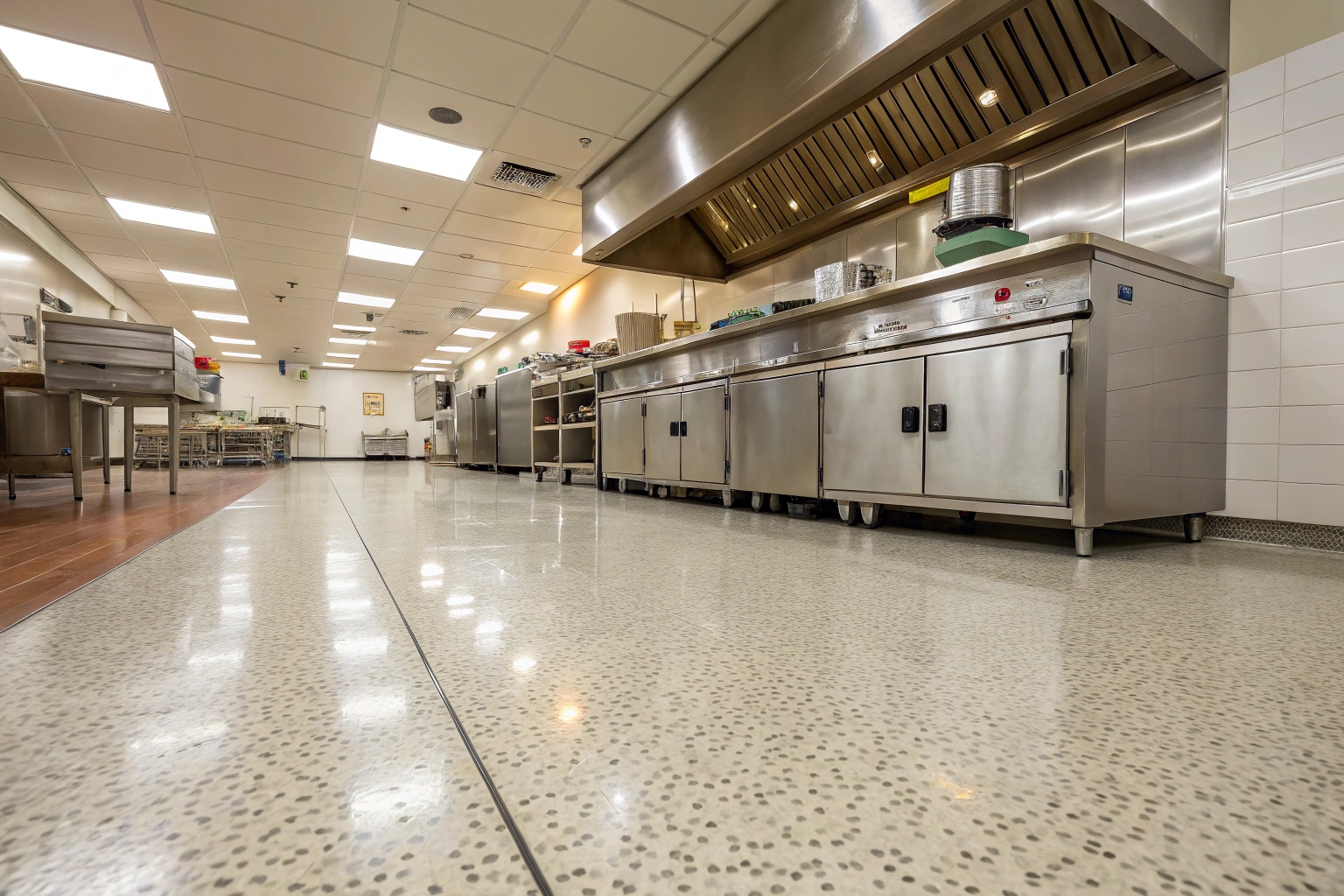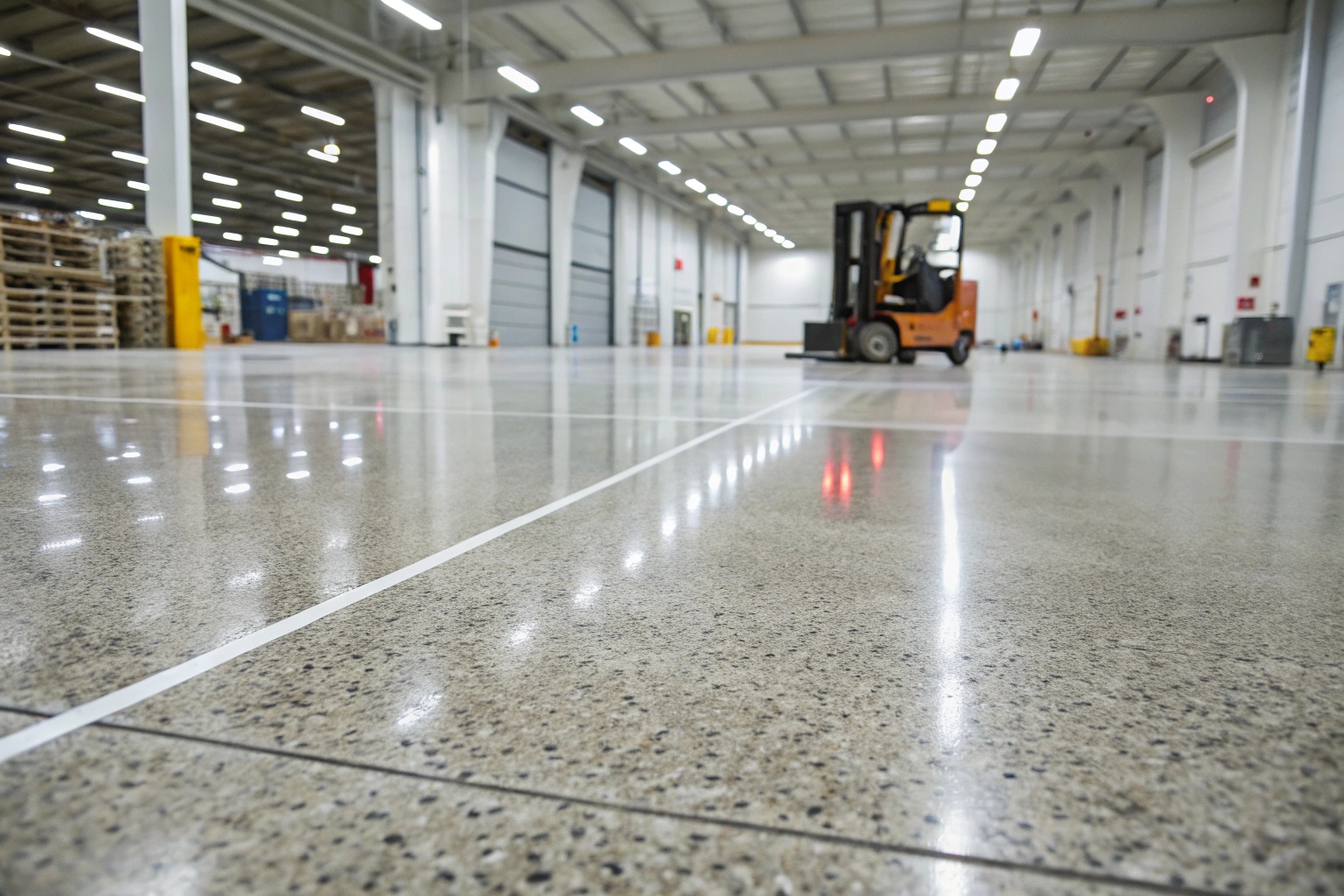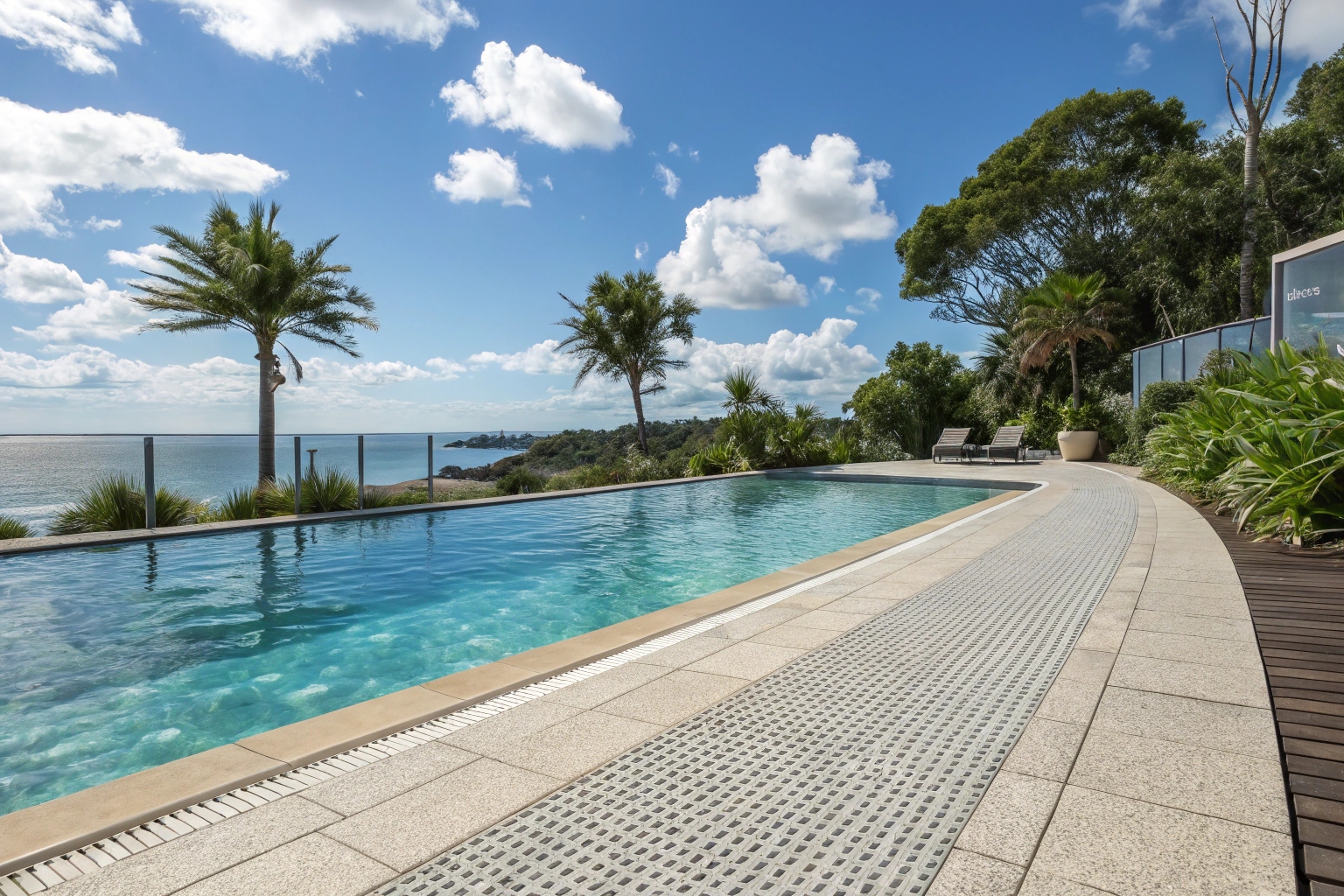What Slip-Resistant Additives Actually Do For Your Floors

Here’s what most people don’t realise until they actually need it – slip-resistant additives aren’t just grit you throw on a floor. They’re engineered materials that change how your surface performs when someone walks on it, especially when things get wet or contaminated.
The additives we use create microscopic peaks and valleys in your floor surface. When someone steps down, their shoe or foot grips these tiny texture points instead of sliding across a smooth surface. It works the same way your car tyres grip the road – the texture breaks through any moisture film and gives you actual contact with the solid surface underneath.
The main benefits you get are:
• Accident prevention – dramatically lower slip and fall risks across your facility
• AS 4586 compliance – meeting the Australian standards that SafeWork NSW actually checks for
• Insurance advantages – many insurers will reduce your premiums when you can prove you’ve got proper slip resistance
• Liability protection – if someone does fall, you’ve got documentation showing you took reasonable safety measures
• Flexible application – works on existing floors without needing complete replacement
What makes additives different from just rough concrete is control. We can dial in exactly how much slip resistance you need. A commercial kitchen needs aggressive traction because floors get covered in grease and water. A retail space needs enough grip for safety but not so much that it’s uncomfortable to walk on. We match the additive type and density to what actually happens in your space day to day.

Common Safety Problems We See Around Wollongong
Walk through any industrial area near Port Kembla and you’ll spot the same issues we get called about every week. Polished concrete that looks great until someone mops it. Epoxy floors in cool rooms that turn into ice rinks when condensation forms. Loading docks where forklifts have worn the texture completely smooth.
The restaurant owners down at the harbour deal with a specific problem – their kitchen floors get hit with fish oils, cleaning chemicals, and constant water. One cafe owner told us his staff were walking around like they were on eggshells every time the floor got mopped. That’s not just uncomfortable, it kills productivity because everyone’s moving slower and more carefully.
The situations that usually trigger a call to us:
• Failed WorkSafe inspections pointing out inadequate slip resistance
• Insurance companies requiring safety upgrades before they’ll renew coverage
• Existing floors that were fine when new but have worn smooth over time
• Wet areas like bathrooms, kitchens, or outdoor spaces that stay slippery
• High-traffic zones where the volume of foot traffic creates accident risks
• Smooth finishes that looked good but nobody thought about safety
Manufacturing facilities have their own challenges. When you’re running equipment that drips hydraulic fluid or coolant, you need floors that maintain grip even with contamination. We worked with a metal fabrication shop in Unanderra where they’d had three incidents in six months – all in the same area where cutting fluid accumulated on the floor.
The pattern we see is people know they’ve got a problem, but they think fixing it means shutting down for days and spending huge money on new floors. That’s where slip-resistant additives change the equation. You’re enhancing what’s already there, not starting from scratch.
How We Install Slip-Resistant Additives Properly
Epoxy removal creates hazards that most people don’t think about until they’re in the middle of a project. We’ve seen DIY attempts go wrong because someone didn’t account for dust, chemical exposure, or proper waste disposal.

Meeting Australian Safety Standards and Compliance
SafeWork NSW doesn’t mess around when it comes to slip resistance, and neither do insurance companies. The standard everyone refers to is AS 4586, which classifies slip resistance using what’s called a P-rating system. P1 is minimal slip resistance, P5 is maximum – and what you need depends entirely on what happens in your space.
A dry office lobby might only need P3 rating. A commercial kitchen legally requires P4 or P5 because you’re dealing with water, oils, and food contaminants constantly. Swimming pool surrounds need specific wet area ratings that are even more stringent. We’ve had clients who thought they were compliant until an auditor showed up with a pendulum tester and proved otherwise.
The testing itself is scientific, not subjective. Pendulum testing measures how much a rubber slider grips your floor surface under controlled conditions. Ramp testing involves walking on an inclined surface that gets progressively steeper until you slip. These aren’t tests you can fake or estimate – the numbers either meet the standard or they don’t.
What compliance actually protects you from:
• WorkSafe citations and penalties during safety inspections
• Insurance claim denials if someone gets injured on your property
• Legal liability in personal injury cases where slip resistance becomes evidence
• Building code violations that can delay or prevent occupancy certificates
We provide proper documentation after every installation. That means test results, certification of the slip resistance rating achieved, and records of what materials were used. When an inspector or insurance assessor asks to see proof of compliance, you’ve got it in writing. That documentation has saved several of our clients from serious legal problems when accidents did occur – they could prove they’d taken reasonable safety measures.

Maintaining Your Slip-Resistant Floors Over Time
Getting slip-resistant additives installed is one thing – keeping them performing properly is another. The good news is maintenance isn’t complicated, but you do need to understand how cleaning affects the texture you’ve paid for.
Regular mopping and scrubbing won’t damage properly installed additives, but harsh chemicals or aggressive equipment can wear them down faster than expected. We had a client who hired a new cleaning company that used a grinding floor scrubber every night. Within six months, they’d polished the additives right off in the high-traffic areas. Simple automatic scrubbers are fine – it’s the abrasive pads and excessive pressure that cause problems.
The texture itself can trap dirt and contaminants if you’re not cleaning properly. That’s actually a good thing for slip resistance – the valleys between additive particles catch debris instead of letting it spread across the smooth surface. But you need to actually remove that trapped material regularly or it builds up and reduces the effectiveness.
Maintenance practices that preserve slip resistance:
• Use pH-neutral cleaners that won’t degrade the coating or additives
• Avoid metal brushes or abrasive pads that mechanically wear down texture
• Clean spills immediately rather than letting them sit and cure on the surface
• Monitor high-traffic areas monthly for signs of additive wear
• Schedule reapplication when slip resistance testing shows degradation
Most additive treatments last years under normal commercial traffic. Food service environments with constant cleaning wear faster – maybe three to five years before you need refreshing. Warehouse floors with forklift traffic might need attention sooner in the tyre paths. We can retest your floors periodically and tell you exactly when performance is dropping below your required rating.
The warranty we provide covers additive performance, not abuse. If you’re maintaining the floor reasonably and the slip resistance fails early, we’ll fix it. If someone’s grinding the texture off with improper equipment, that’s a different conversation.
Frequently Asked Questions About Slip-Resistant Additives
Most installations finish in one to two days depending on the size of your area. We apply the coating with additives, let it cure properly, then do final testing. Small spaces like a single bathroom might only take a few hours. A large warehouse floor obviously takes longer. The good part is you’re not waiting weeks – we can usually schedule you within days of your call and have you back operational quickly.
Not if we match the right additive type to your space. Aggressive silicon carbide in a commercial kitchen feels different underfoot than polymer beads on a pool deck, but neither should be painful or uncomfortable. We’ve done hundreds of these installations and people adjust to the texture within days. The alternative – slipping and falling – is way more uncomfortable than a textured floor.
Absolutely. That’s one of the most common applications we do. Your existing epoxy doesn’t need to come out. We prepare the surface, apply a compatible topcoat with additives broadcast into it, and you’ve got slip resistance without the cost and downtime of a complete floor replacement. Works on concrete, tile, and most other hard surfaces too.
Depends on the area size, which additive type you need, and how much prep work your existing floor requires. Small projects might run a few thousand dollars. Large commercial spaces cost more but remember you’re comparing that to potential lawsuit costs, insurance claims, or WorkSafe penalties. Call us at 0242026324 for an actual quote based on your specific situation.
We monitor that through periodic testing if you want, or you can contact us when you notice performance dropping. Reapplication is straightforward – we add a fresh topcoat with new additives. Usually costs less than the original installation because the base floor is already prepared and sealed.
Get Professional Slip-Resistant Treatment for Your Wollongong Floors
You know whether your floors are a safety problem or not. Maybe you’ve already had a close call, or maybe you’re just tired of worrying every time someone walks across a wet surface. Either way, waiting doesn’t make the situation better – it just increases the chances of something happening that costs you way more than prevention would have.
Local Epoxy Flooring Wollongong has installed slip-resistant additives across the Illawarra region for over a decade. We’ve worked with manufacturing facilities, commercial kitchens, healthcare centres, retail spaces, and residential properties. Every project gets the same attention to proper preparation, correct additive selection, and testing to verify you’re actually meeting the safety standards you need.
When you work with us, here’s what happens:
• Free site assessment where we evaluate your specific slip hazards and requirements
• Honest recommendations about which additive type and density suits your environment
• Professional installation with minimal disruption to your operations
• Testing and documentation proving compliance with AS 4586 standards
• Warranty coverage protecting your investment in safety improvements
The conversation starts with a phone call. We’ll ask about your space, what kind of traffic and conditions you deal with, and whether you’ve got specific compliance requirements to meet. Then we’ll come look at the actual floors and give you a realistic quote – no hidden costs, no pressure, just information you can use to make a decision.
Stop putting off a safety issue that’s only going to get more expensive the longer you wait. Call Local Epoxy Flooring Wollongong at 0242026324 today. We’ll schedule your assessment, usually within the same week, and show you exactly what slip-resistant additives can do for your property. Your floors should be something you trust, not something you worry about.

